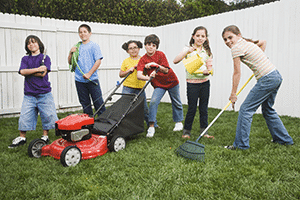
There are an estimated 15 million summer-time latchkey kids (ages 5-12 who stay home alone) in the U.S., and you’d think that these kids would naturally be drawn to visiting the local pool or running around outside with friends. Instead, they use the summer to sit around and engage in obesity-related behaviors like watching TV, playing video games, eating sugary snacks and fewer vegetables according to a study from Columbia University’s Mailman School of Public Health.
To help combat this problem, just about every professional sports organization has launched a campaign to promote healthy kids. But what if you can’t connect with one of them or live in an area where these programs don’t exist?
Gregg Murset, CEO of BusyKid, recommends that parents take control of the situation and use these tips to put a plan in place that will keep kids active all summer long, make things easier on parents and cut down on that phrase parents dread to hear, “I’m bored.”
1. Communicate Your Expectations
Sit down with your kids and lay out a plan, as well as, what you expect. Clearly, older kids will have more responsibility, but that doesn’t mean the little ones get off easy.
2. Schools Out For Summer, No Laying Around
Kids need to be active every day so don’t leave home projects, chores or personal activities on the weekends. Make sure there are a handful of projects to be completed every day, including ones that help you like fixing dinner, doing dishes or laundry.
3. Build a “Busy Calendar” For The Kids
Use a tool like BusyKid that can be your “Busy Calendar.” Each day kids can see what needs to be done and can click projects/activities one at a time. This will help teach them responsibility, accountability and time management.
4. Assign By Strengths
Different kids are good at different things. Maybe one of your kids hates doing things outside. Perhaps another loves the sunshine and fresh air. Besides assigning things by age, look at what they like doing and build the calendar from there.
5. Find Balance
Make sure the “Busy Calendar” has a good balance of chores and fun. For every hour of tasks, try to have one hour of another activity where your kids can enjoy themselves. After all, it’s their summer too.
6. Step It Off
If your child has a mobile phone, chances are it comes with a health app that can count steps. If it doesn’t, there are plenty available. Add one and have a weekly contest to see who puts in the most miles.
7. Reward Success
If all goes according to your plan, your kids will be moving around a bunch this summer, and plenty of projects will be done. Make sure to reward them for working hard or staying with the plan. Paying an allowance is a great way to reward your kids and using BusyKid will help them learn how to save, spend and invest it wisely.












